Broccoli
| Broccoli | |
|---|---|
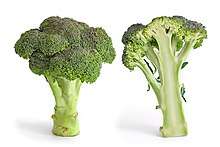 | |
| Species | Brassica oleracea |
| Cultivar group | Italica |
| Origin | Italy, more than 2,000 years ago[1][2] |
Broccoli is an edible green plant in the cabbage family whose large flowering head is eaten as a vegetable.
The word broccoli comes from the Italian plural of broccolo, which means "the flowering crest of a cabbage", and is the diminutive form of brocco, meaning "small nail" or "sprout".[3] Broccoli is often boiled or steamed but may be eaten raw.[4]
Broccoli is classified in the Italica cultivar group of the species Brassica oleracea. Broccoli has large flower heads, usually green in color, arranged in a tree-like structure branching out from a thick, edible stalk. The mass of flower heads is surrounded by leaves. Broccoli resembles cauliflower, which is a different cultivar group of the same species.
Broccoli is a result of careful breeding of cultivated Brassica crops in the northern Mediterranean starting in about the 6th century BC.[5] Since the time of the Roman Empire, broccoli has been considered a uniquely valuable food among Italians.[6] Broccoli was brought to England from Antwerp in the mid-18th century by Peter Scheemakers.[7] Broccoli was first introduced to the United States by Southern Italian immigrants, but did not become widely popular until the 1920s.[8]
Varieties

There are three commonly grown types of broccoli. The most familiar is Calabrese broccoli, often referred to simply as "broccoli", named after Calabria in Italy. It has large (10 to 20 cm) green heads and thick stalks. It is a cool season annual crop. Sprouting broccoli has a larger number of heads with many thin stalks. Purple cauliflower is a type of broccoli grown in Europe and North America. It has a head shaped like cauliflower, but consisting of tiny flower buds. It sometimes, but not always, has a purple cast to the tips of the flower buds.
Other cultivar groups of Brassica oleracea include cabbage (Capitata Group), cauliflower and Romanesco broccoli (Botrytis Group), kale and collard greens (Acephala Group), kohlrabi (Gongylodes Group), Brussels sprouts (Gemmifera Group), and kai-lan (Alboglabra Group).[9] Rapini, sometimes called "broccoli raab" among other names, forms similar but smaller heads, and is actually a type of turnip (Brassica rapa). Broccolini or "Tenderstem broccoli" is a cross between broccoli and Chinese broccoli. Beneforté is a variety of broccoli containing 2–3 times more glucoraphanin that was produced by crossing broccoli with a wild Brassica variety, Brassica oleracea var villosa.[10]
Production
| Broccoli production—2014 includes cauliflower,[11] millions of tonnes | |
|---|---|
| Country | Production |
| World | |
In 2014, global production of broccoli (combined for production reports with cauliflowers) was 24.2 million tonnes, with China and India together accounting for 74% of the total (table).[11] Secondary producers, each having one million tonnes or less annually, were the United States, Spain, Mexico and Italy (table).[11] The US Department of Agriculture reported that national production just of broccoli in 2014 was 0.95 million tonnes, nearly all of which was grown in California.[12]
Cultivation
Broccoli is a cool-weather crop that does poorly in hot summer weather. Broccoli grows best when exposed to an average daily temperature between 18 and 23 °C (64 and 73 °F).[13] When the cluster of flowers, also referred to as a "head" of broccoli, appear in the center of the plant, the cluster is green. Garden pruners or shears are used to cut the head about an inch from the tip. Broccoli should be harvested before the flowers on the head bloom bright yellow.[14]
While the heading broccoli variety performs poorly in hot weather, mainly due to insect infestation, the sprouting variety is more resistant, though attention must be paid to sucking insects (such as aphids), caterpillars and whiteflies. Spraying of bacillus thuringiensis can control caterpillar attacks, while a citronella vase may ward off whiteflies.[15]
Pests
Mostly introduced by accident to North America, Australia and New Zealand, "cabbage worms", the larvae of Pieris rapae, the small white butterfly are a common pest in broccoli.[16]
Nutrition
| Nutritional value per 100 g (3.5 oz) | |
|---|---|
| Energy | 141 kJ (34 kcal) |
|
6.64 g | |
| Sugars | 1.7 g |
| Dietary fiber | 2.6 g |
|
0.37 g | |
|
2.82 g | |
| Vitamins | Quantity %DV† |
| Vitamin A equiv. |
4% 31 μg3% 361 μg1403 μg |
| Thiamine (B1) |
6% 0.071 mg |
| Riboflavin (B2) |
10% 0.117 mg |
| Niacin (B3) |
4% 0.639 mg |
| Pantothenic acid (B5) |
11% 0.573 mg |
| Vitamin B6 |
13% 0.175 mg |
| Folate (B9) |
16% 63 μg |
| Vitamin C |
107% 89.2 mg |
| Vitamin E |
5% 0.78 mg |
| Vitamin K |
97% 101.6 μg |
| Minerals | Quantity %DV† |
| Calcium |
5% 47 mg |
| Iron |
6% 0.73 mg |
| Magnesium |
6% 21 mg |
| Manganese |
10% 0.21 mg |
| Phosphorus |
9% 66 mg |
| Potassium |
7% 316 mg |
| Sodium |
2% 33 mg |
| Zinc |
4% 0.41 mg |
| Other constituents | Quantity |
| Water | 89.3 g |
|
| |
| |
|
†Percentages are roughly approximated using US recommendations for adults. Source: USDA Nutrient Database | |
As shown on the table, a 100 gram serving of raw broccoli provides 34 kcal and is an excellent source (20% or higher of the Daily Value, DV) of vitamin C and vitamin K. Raw broccoli also contains moderate amounts (10–19% DV) of several B vitamins and the dietary mineral manganese, whereas other essential nutrients are in low content. Broccoli has low content of carbohydrates, protein, fat, and dietary fiber.
Boiling broccoli reduces the levels of sulforaphane, with losses of 20–30% after five minutes, 40–50% after ten minutes, and 77% after thirty minutes.[17] However, other preparation methods such as steaming,[18] microwaving, and stir frying had no significant effect on the compounds.[17]
Broccoli also contains the carotenoid compounds lutein and zeaxanthin in amounts about 6 times lower than in kale.
Taste
The perceived bitterness of cruciferous vegetables such as broccoli varies from person to person, but the functional underpinnings of this variation are not known. Some research reports that the gene TAS2R38 may be responsible for bitter taste perception in broccoli.[19] Other factors, such as isothiocyanates and polyphenols, are also likely involved in bitterness perception.[20]
Gallery

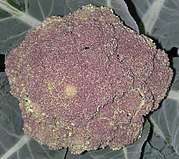
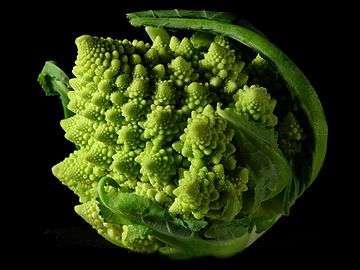
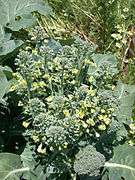
See also
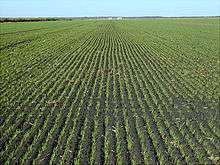

- Broccolini
References
- ↑ Buck, P. A (1956). "Origin and taxonomy of broccoli" (PDF). Economic Botany. 10 (3): 250–253. doi:10.1007/bf02899000. Retrieved 24 April 2012.
- ↑ Stephens, James. "Broccoli—Brassica oleracea L. (Italica group)". University of Florida. p. 1. Retrieved 14 May 2009.
- ↑ "broccoli". Merriam-Webster's Collegiate Dictionary (11th ed.). p. 156. ISBN 978-0-87779-809-5. Retrieved 9 April 2014.
- ↑ "Broccoli Leaves Are Edible". Garden Betty. Retrieved 8 May 2013.
- ↑ Maggioni, Lorenzo; Bothmer, Roland; Poulsen, Gert; Branca, Ferdinando (2010). "Origin and Domestication of Cole Crops (Brassica oleracea L.): Linguistic and Literary Considerations". Economic Botany. 64 (2): 109–123. doi:10.1007/s12231-010-9115-2.
- ↑ Nonnecke, Ib (November 1989). Vegetable Production. Springer-Verlag New York, LLC. p. 394. ISBN 978-0-442-26721-6.
- ↑ Smith, J.T. Nollekins and His Times, 1829 vol. 2:101: "Scheemakers, on his way to England, visited his birth-place, bringing with him several roots [sic] of brocoli, a dish till then little known in perfection at our tables."
- ↑ Denker, Joel (2003). The world on a plate. U of Nebraska Press. p. 8. ISBN 978-0-8032-6014-6. Retrieved 24 April 2012.
- ↑ Dixon, G.R. (2007). Vegetable brassicas and related crucifers. Wallingford: CABI. ISBN 978-0-85199-395-9.
- ↑ "About Beneforte". superbroccoli.info.
- 1 2 3 "Production/Crops, Quantities by Country for Cauliflowers and Broccoli for 2014". Food and Agricultural Organization of the United Nations, Statistics Division (FAOSTAT). Retrieved 25 April 2017.
- ↑ "California Drought: Crop Sectors". US Department of Agriculture, Economic Research Service. 3 February 2017. Retrieved 2017-04-25.
- ↑ Smith, Powell (June 1999). "HGIC 1301 Broccoli". Clemson University. Retrieved 25 August 2009.
- ↑ Liptay, Albert (1988). Broccoli. World Book, Inc.
- ↑ Takeguma, Massahiro (26 May 2013). "Cultivo da Couve Brócolis (Growing Sprouting Broccoli)".
- ↑ editors, J. Richard and Joan E. Heitzman; Jim Rathert, principal photographer; Kathy Love and LuAnne Larsen, (1996). Butterflies and moths of Missouri. Jefferson City, MO: Missouri Dept. of Conservation. ISBN 1-887247-06-8.
- 1 2 Warwick Medical School, University of Warwick (15 May 2007). "Research Says Boiling Broccoli Ruins Its Anti Cancer Properties".
- ↑ "Maximizing The Anti-Cancer Power of Broccoli". Science Daily. 5 April 2005.
- ↑ Lipchock SV, Mennella JA, Spielman AI, Reed DR (2013). "Human bitter perception correlates with bitter receptor messenger RNA expression in taste cells". Am J Clin Nutr. 98 (4): 1136–43. doi:10.3945/ajcn.113.066688. PMC 3778862. PMID 24025627.
- ↑ Wooding S, Gunn H, Ramos P, Thalmann S, Xing C, Meyerhof W (2010). "Genetics and bitter taste responses to goitrin, a plant toxin found in vegetables". Chem Senses. 35 (8): 685–92. doi:10.1093/chemse/bjq061. PMID 20551074.
External links
| Wikimedia Commons has media related to Broccoli. |
- PROTAbase on Brassica oleracea (cauliflower and broccoli)
- List of North American broccoli cultivars, USDA/ARS Vegetable Laboratory
- Lee, Lisa-Ann (February 22, 2017). "Creating a broccoli for all seasons to hedge against climate change". newatlas.com. Retrieved 2017-02-26.